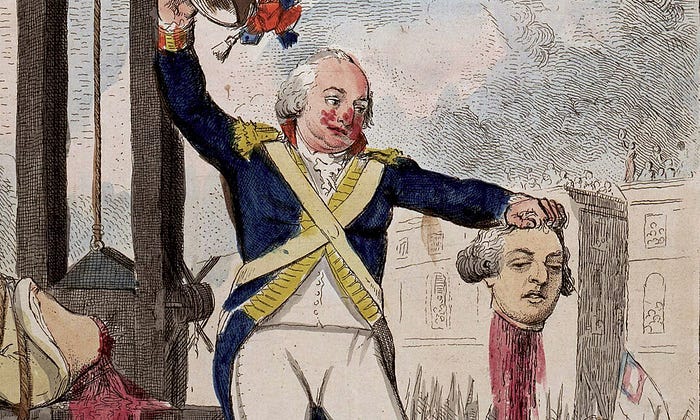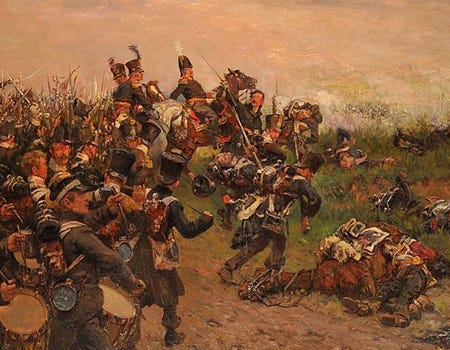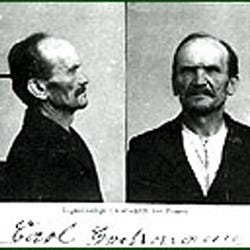Four Weird (Yet Disturbing) Facts From History
Tales of blood, teeth, sausages, and a remarkable chicken

Human beings are naturally drawn to the strange and the unsettling. It’s why we watch horror movies, suspenseful thrillers, or documentaries about peculiar events from our past.
The following article offers a mix of weird and disturbing information, ranging from royal beheadings to death-defying farm animals. If you’re looking for quirky pieces of history, this is the right place to be.
1. French Citizens Dipped Their Handkerchiefs in Louis XVI’s Blood

The French Revolution is one of the most well-known events in modern history. Celebrated by some and condemned by others, it’s a fascinating tale featuring plenty of bloody beheadings.
The most famous victim of the French Revolution was Louis XVI, the last King of France. Louis was executed on the 21st of January 1793. The guillotine blade sliced off the king’s head, and the crowd began to chant: “Long live the republic! Long live liberty! Long live equality!”
Despite the best efforts of the guards, some members of the crowd surged forward and surrounded the guillotine. They dipped their handkerchiefs in the red fluid oozing from the king’s severed head, hoping to soak up some royal blood.
Louis was the prime enemy of the French Revolution, but his blood was still valuable. Indeed, these bloodied handkerchiefs became cherished relics in the nineteenth century.
2. There Was a Market For Dead Soldiers’ Teeth in the Early Nineteenth Century

Colonialism led to many sugary treats for the people of Europe. However, the drawback of this development was an increase in tooth decay, resulting in a demand for fresh sets of teeth.
This led to a weird phenomenon involving thieves who followed armies around Europe and — once the fighting was over — removed teeth from the mouths of dead soldiers. The fact the teeth came from dead soldiers was a positive selling point, for soldiers were typically fit and healthy.
The teeth-collecting industry boomed following the Battle of Waterloo in 1815. The supply of dead soldiers’ teeth rocketed, and owning a set of “Waterloo Teeth” was something to be proud of.
Though artificial teeth started to take over in the 1840s, soldiers’ teeth continued to be collected from battlefields in the second half of the nineteenth century. During the American Civil War (1861–1865), for instance, teeth were shipped from the American battlefields to the markets of Europe.
3. A German Serial Killer Made Hotdogs Using Human Flesh

Who are the most famous serial killers of all time? Jack the Ripper, Ted Bundy, and Harold Shipman are the names that spring to mind. But chances are you haven’t heard of Carl Großmann.
Großmann was a German serial killer who started committing murder during the tumult of the First World War. He carried out his crimes in Berlin, preying on young women leaving the train station. He would offer them a job as a housekeeper and take them back to his flat.
Once inside, Großmann murdered his victims, pickled their flesh, and mixed them into the sausages for his hot dogs. He sold these hot dogs at the train station, and his customers had no idea they were eating human flesh.
Großmann continued to do this for six years or so, murdering approximately fifty young women. Eventually, the neighbours noticed a horrible, fleshy substance coming from Großmann’s drainpipe and contacted the police.
After breaking into Großmann’s flat, the police discovered a dead girl lying on the bed, along with many items belonging to previous victims. They arrested Großmann and placed him in prison, where he hanged himself before his trial.
4. A Headless Chicken Lived For Eighteen Months

Mike was a Wyandotte chicken who lived on a farm in Fruita, Colorado. On the 10th of September 1945, Mike’s owners, Lloyd and Clara Olsen, decided to slaughter some of the chickens on their farm for extra money.
But Mike managed to survive the slaughter. Though his head was lying on the floor, his body still functioned. Lloyd was amazed by what he saw and decided to keep Mike alive for as long as possible. He did this by squirting a mixture of grain and water through Mike’s open oesophagus.
Lloyd and Clara decided to monetize their miracle chicken by taking him on tour. People up and down the West Coast of America paid to see Mike, bringing in a total of $4,500 a month — which was a lot in those days.
Scientists who examined Mike found an explanation for his prolonged survival. Most of a chicken’s reflex actions are in the brain stem. Crucially, this part of Mike’s body remained intact. The cut to his neck missed the jugular vein, and a clot prevented him from bleeding to death.
Lloyd and Clara had to keep an eye on Mike, for he often choked on his own mucus. They solved this problem by using a syringe to suck away the mucus. But on the 17th of March 1947, they misplaced their syringe whilst staying at a hotel, and Mike the Headless Chicken was no more.





